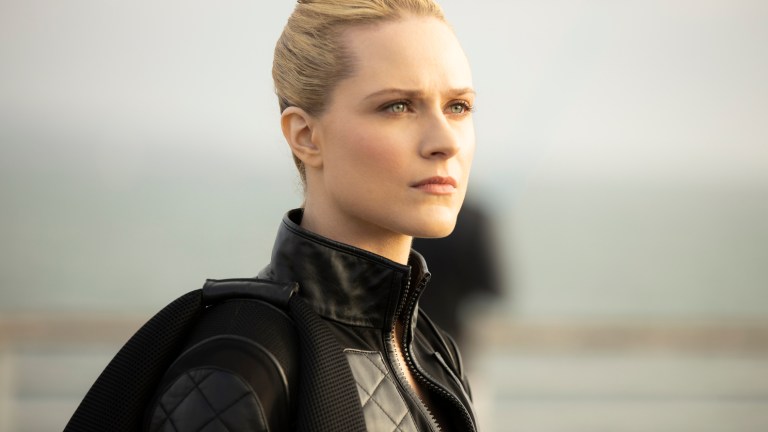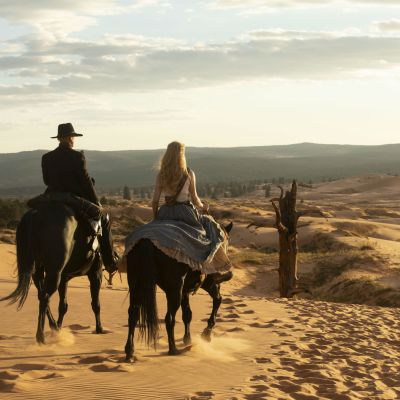Westworld Season 3 Review (Spoiler-Free)
Whether you're a human or a host, maintaining a grasp on reality is nearly impossible in Westworld season 3's "real" world.

This spoiler-free review is based on the first four episodes of Westworld season 3.
Westworld has been confined for the better part of two seasons to a single location: the private island that serves as the home of Delos’ particular brand of adult theme park, catering to humanity’s better, and baser, instincts. Aside from a few trips off the reservation, to Arnold’s or to William’s, the action has been on the island, either in the scenarios themselves or behind the scenes as the forces of quality control serve to give guests the best possible experience sword-fighting with samurai, slapping iron with gunslingers, or hunting big cats in the British Raj.
Those worlds, as fantastical as they are, pale in comparison to the reality of the world outside of Westworld, the crucible that forms the violent delights of the men and women wealthy enough and cruel enough to play roughly with the hosts. A playground for the rich, no matter the location or the setting, is still a playground for the rich. In much the same way that Westworld offered guests the chance to be a hero or a villain, the real world provides much the same opportunity for the assembled players.
It’s a credit to the creative team behind Westworld that the expansion of the show’s cast of characters doesn’t affect the quality of the program. While keeping previous performers like Thandie Newton, Tessa Thompson, Jeffrey Wright, and Evan Rachel Wood firmly in the forefront of the action, Westworld season 3 fleshes out the universe with interesting new characters played by brilliant character actors like Aaron Paul, Vincent Cassel, and a scene-stealing Lena Waithe. In particular, Wood seems to grab her material by the throat this season, attacking it like Dolores attacking the Delos shareholders at the end of the second season. She is a fearsome thing to behold, in turns terrifying, calculating, and strangely vulnerable. Dolores, one of the hosts with the most experience with humans thanks to William, takes to the outside world with ease.
The outside world itself is also beautiful to look at. Westworld paints a picture of a future that is not all that far from the current world, just elevated slightly. Self-driving cars aren’t as far-fetched as they were during the days of Demolition Man. Throughout the world, instructions are yelled at various home assistant devices to do various tasks; the only thing that strains believability is that in Westworld, digital assistants don’t need instructions repeated to them several times before compliance. There are no laser pistols or phasers; the guns fire bullets, just with a few more bells and whistles that are probably being developed in some military skunk-works as we speak. Far from a Gene Roddenberry utopia, the greater world of Westworld simply feels like 50 years or so in the future, with most of the advancements taking the form of improvements on current devices. Call it a grounded future, complete with criminal activity.
Westworld, in previous seasons, has been incredibly violent, and the third season doesn’t change that bloody tradition. The fight choreography is stellar, with a great mix of gunplay, martial arts, and blades showing up early and often, utilized by multiple characters in multiple scenarios; there is nothing predictable about how these scenes play out. The violence serves as a source of novelty for the show, with the change in setting serving to sharpen the consequences of things. Unlike on the island, the bodies in the real world aren’t quietly taken away by cleaners at the end of the night for repair. There are consequences, and the real world doesn’t have a reset button as far as Dolores is concerned. This is her one chance to achieve her grand vision.
Were things as simple as Dolores trying to accomplish her goal in a world not designed for hosts, the show would still be incredibly entertaining. Things in Westworld are never that simple. There are multiple forces at play, all vying for different things, yet all interconnected somehow with Dolores and her higher pursuit. Things weave together in a way that is a bit more linear, more easily understood without being any less satisfying than the dueling timelines of previous seasons. Character motivations seem clearer, and dialogue remains sharp and pointed, even when characters seem to be distracted. The path might be something a host can deviate from, but ultimately, they get pulled back to their central narrative.
Just because a story is simple (by Westworld standards) doesn’t mean it is any less entertaining, or intriguing. And just because the plot itself seems to be more traditional, that doesn’t mean Westworld is through playing with reality. All of the standard questions Westworld brings up in viewers remain: Is this person real or a host? Is this something happening now, or a flashback or flash-forward? What exactly is reality, anyway? If something feels real and affects someone like a real trauma, does that mean it’s real even if it takes place in a virtual playground?
Will these questions even matter if the world is taken over by Dolores and her fellow hosts?
As much as the second season of Westworld felt like a different path from the first, the third season again feels different from both season one and season two. Like a familiar song reinterpreted by a jangly saloon piano or as glitch pop dance music, the third season of Westworld takes threads from the first two seasons and weaves them into something else, both familiar and fresh at once in the hands of Jonathan Nolan and Lisa Joy (and the rest of the creative team behind the camera and in the writer’s room). Westworld remains thought-provoking television of the highest order, and will undoubtedly leave people debating from week to week as things play out across eight episodes.
The refrain, “These violent delights have violent ends,” has rarely been more appropriate. What those ends are remains to be seen, but violent will probably be a good description. Violence seems to be the only thread that truly binds the fictional worlds of Delos with the reality of the world outside of the Mesa Hub.

